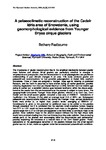A palaeoclimatic reconstruction of the Cadair Idris area of Snowdonia, using geomorphological evidence from Younger Dryas cirque glaciers
| dc.contributor.author | Radbourne, B. | |
| dc.date.accessioned | 2019-05-17T11:29:43Z | |
| dc.date.available | 2019-05-17T11:29:43Z | |
| dc.date.issued | 2015 | |
| dc.identifier.citation |
Radbourne, B. (2015) ' A palaeoclimatic reconstruction of the Cadair Idris area of Snowdonia, using geomorphological evidence from Younger Dryas cirque glaciers', The Plymouth Student Scientist, 8(2), p. 217-257. | en_US |
| dc.identifier.issn | 1754-2383 | |
| dc.identifier.uri | http://hdl.handle.net/10026.1/14105 | |
| dc.description.abstract |
The importance of glacier reconstruction lies in the empirical relationship between glacier mass balance and climate. Small glaciers are particularly sensitive to changes in temperature and precipitation, thus the reconstruction of small palaeoglaciers can provide an understanding of past climatic changes in an area. This study conducts glacier and palaeoclimatic reconstructions for four potential palaeoglaciers at Cadair Idris, southern Snowdonia. Three of these are assigned a Younger Dryas age by referring to published literature, and the fourth is assumed to have existed during an earlier glaciation, possibly reflecting deglaciation from the Last Glacial Maximum (LGM). Schmidt Hammer relative age dating is carried out to establish relative ages between landforms within the cirque areas, however the results from this are inconclusive as the process is subject to many errors. The topographically-constrained Younger Dryas cirque glaciers, referred to as Cwm Cau, Cwm Gadair and the small eastern glacier, occupied a total area of 0.963km2. Calculations of Equilibrium Line Altitudes (ELAs) yield an average local ELA of 607m asl. Subsequent palaeoclimatic reconstructions indicate that during the Younger Dryas, annual precipitation levels were similar to, or higher than, present levels, averaging at 2850mm a-1. Consideration is given to the potential for additional mass to be added to the glaciers through snowblow, but it is concluded that the relatively small snowblow factors, ranging from 0.71 to 1.32, would not have contributed much mass to the glaciers. Total avalanche factors range from 0.27 to 0.92 and are suggested to be more likely to contribute mass to the glaciers. Solar radiation maps for the ablation season indicate that the high cirque walls would have provided shading from the most intense incoming solar radiation, thus protecting certain parts of the glaciers and encouraging initial ice accumulation and preservation, possibly explaining the existence of a western lobe of the Cwm Gadair glacier. Finally, calculations of the glaciological dynamics of the glaciers indicate that the small eastern glacier was not, in fact, viable as a glacier under the reconstructed palaeoclimatic conditions. | en_US |
| dc.language.iso | en | en_US |
| dc.publisher | University of Plymouth | |
| dc.rights | Attribution 3.0 United States | * |
| dc.rights.uri | http://creativecommons.org/licenses/by/3.0/us/ | * |
| dc.subject | glacier reconstruction | en_US |
| dc.subject | glacier mass balance and climate | en_US |
| dc.subject | palaeoglaciers | en_US |
| dc.subject | Cadair Idris | en_US |
| dc.subject | southern Snowdonia | en_US |
| dc.subject | Equilibrium Line Altitudes | en_US |
| dc.subject | Solar radiation maps | en_US |
| dc.subject | Solar radiation | en_US |
| dc.title | A palaeoclimatic reconstruction of the Cadair Idris area of Snowdonia, using geomorphological evidence from Younger Dryas cirque glaciers | en_US |
| dc.type | Article | |
| plymouth.issue | 2 | |
| plymouth.volume | 8 | |
| plymouth.journal | The Plymouth Student Scientist |



